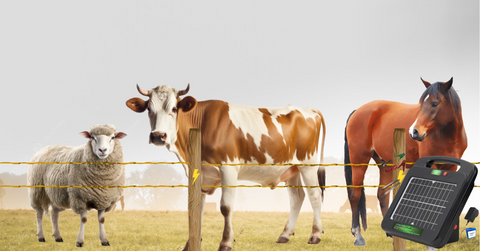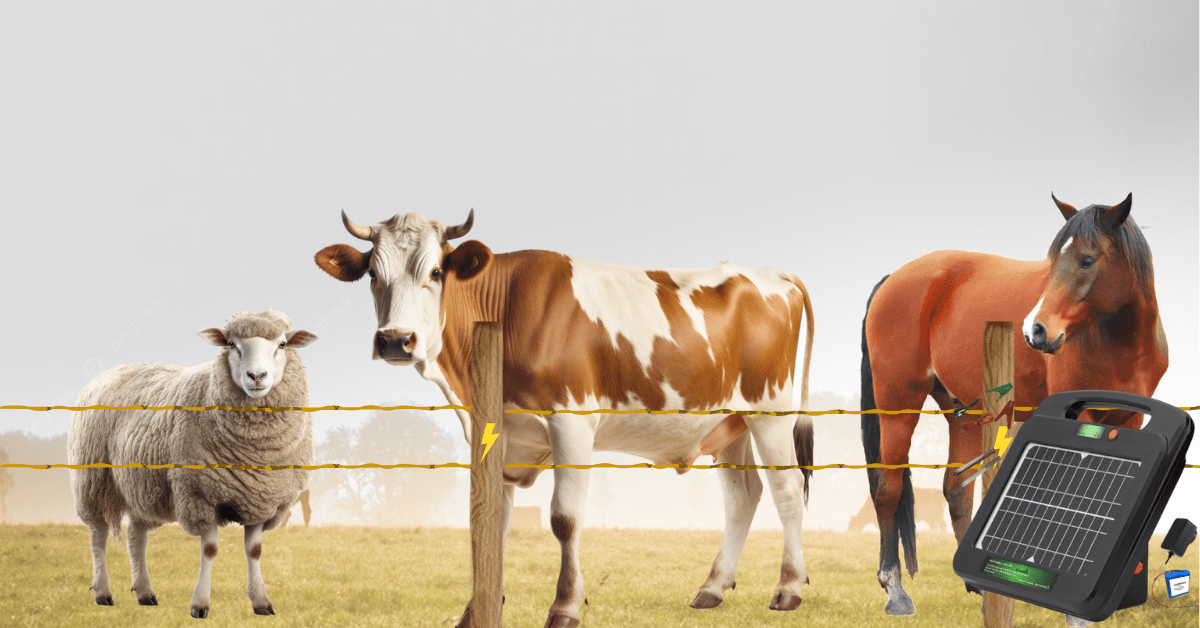
Electric fence energizers are electronic components used to power electric fences. Ideally, the My Animal Command electric fence chargers use solar energy as a power source, making them a cheaper and environmentally friendly option.
In this article, we will look at the solar energizer’s installation process, testing methods, safety precautions, and the different uses for solar-powered electric fence energizers.
How to Connect the Electric Fence and How the Energizer Works
Our electric fence energizers are easy to install and connect.
Our model MAC3ML box of solar-powered fence energizer kit comes with (1) Solar fence Energizer Kit, (1) 19” (50cm) Earthing Rod, 2 x 3.3Ft (1m) Crocodile Cable connectors, and (1) 12Volts/2A Wall adapter
- The first step is to ensure electric fence chargers are turned off after unboxing. To do it, press the red power button at the face of the kit to turn it off.
- Next, connect the wall adapter charging cable from the DC port to a power outlet to Manually charge the unit for approximately 8 hours until it is full. This is highly recommended for all first-time installations. You Can also Manually Charge it from time to time as required
- Next, take the kit outside and mount it strategically using the built-in mounting system where it receives maximum sunlight.
- Check the red and black terminals at the back of the energizer kit and attach the red crocodile cable connector to the red terminal and the green crocodile cable connector to the black terminal.
- Afterward, connect any standard poly fence wire or your fence to the red clip or run it to the poultry netting or fence, and the green crocodile clip to the earthing rod in the ground. The earthing rod should be inserted firmly into the ground. My Animal Command’ Energizer Kit comes with a 19” Earthing rod and can be used as a starter pack only. Get any other bigger or longer earthing rods of your choice if required
- Once installation is complete Turn your energizer ON, the fence will be energized with 0.25 joules of pulsed electrical output (9-11Kv), making it safe for livestock. Any animal touching the wire completes the circuit to the ground, and the energized fence delivers a mild jolt. Eventually, any animal will recognize the electric fence and won’t touch or come closer.
How An Electric Fence Energizer Works
Usually, a solar-powered electric fence system has three main components: a Rechargeable Battery, a solar Panel, and a primary winding circuitry to produce a high but safe voltage.
The voltage unit produces an electrical charge that runs through the fence wire. The earth terminal connects the charger to the ground and prevents short circuits. Lastly, the primary winding converts solar energy into electrical energy to power the charger.
Fencing chargers convert power (in this case, from a solar panel) into high-voltage pulses that travel through the fence wire every 1-2 seconds. When an animal or person comes into contact with the electrified wire, they complete the electrical circuit to the ground, receiving a short, mild shock. This deters them from crossing the barrier without causing serious harm.
Remember, the power should charge up to 3 miles (5 km), ensuring safe containment for your livestock.
My Animal Command Fence charger has a water-resistant 6W solar panel for fast charging via daylight and sunlight, and the large capacity Internal rechargeable 75-watt hour Lithium-Ion battery can last up to 15 days in total darkness.
How to Test the Electric Fence Energizer Safely
Testing the electric fence energizer is easy.
- First, turn on the power button on the kit. You can hear a soft ticking sound or blinking light (pulse) on the kit every second after installation to know it functions correctly.
- Secondly, you can use a digital electric fence Kilovoltmeter, which is the most common way to test an electric fence energizer.
Here are the steps to follow.
- Connect the voltmeter to the fence using the provided leads, depending on the design of your voltmeter.
- Turn on the energizer. Here, the voltmeter should display the voltage output of the energizer, allowing you to check if it is functioning correctly.
- Lastly, use an electric fence voltmeter to measure the voltage on the earthing rod.
Check out this Video guide for a more detailed step-by-step procedure.
Note: Charging the Li-ion batteries in the energizer kit with an adapter after 3 months of use is always recommended to maintain the battery life for up to 4 years.
Electric Fence Uses
With an output of 0.25 joules and a voltage range of 9-11KV, the My Animal Command portable solar-powered energizer charger offers efficient and reliable boundary control of up to 3 miles (5km) with a single strand of electric wire.
Here are the most common applications:
- Livestock Containment on Farms: This device guarantees the safety and containment of cattle, sheep, goats, and other domestic livestock within a designated area, usually up to 360 acres. This significantly helps manage the animals and prevent wanderlust or potential roadway accidents.
- Poultry Netting: - Use it to protect your Poultry/Chickens with any Standard Poultry netting
- Electric fence energizer for dogs in urban homes: Homeowners in residential areas can now secure their pets within the bounds of their property, offering peace of mind for the owner and the dog’s safety. Unlike traditional fences with barbed edges, the electric fence gently discourages dogs from crossing boundaries by using a harmless but powerful shock.
- Electric fence in emergencies: Utilizing solar power after a natural disaster helps contain animals that need shelter or those waiting for evacuation.
- A portable solution for large farms: My Animal Command fence energizer is especially beneficial for ranchers and farmers who want to change enclosures or manage fences across large expanses of land where no power is available
- Protection from predators: The electric fence keeps predators at bay. For instance, a poultry farmer can install an electric fence energizer along the poultry netting fence to create a barrier that ensures a safe environment for chickens and other birds.
- Garden protection: An electric fence can also keep unwanted animals like rabbits, squirrels, and deer out of your garden or farm, preventing damage to crops and vegetables without causing harm to them.
- Electric fence energizer for horses: Owners of horses will find the portable charger flexible for partitioning pastures and creating temporary enclosures or strip grazing during events or horseback riding trails.
Is the Electric Fence Safe for Small Animals?
Yes. The electric fence system is safe for small animals. However, a user must install it according to the user manual to prevent potential harm.
My Animal Command solar-powered animal electric fence energizer uses 0.25 joules of safe pulse voltage that does not cause harm to an animal.
Tips- The spacing between wires should be narrow enough to prevent small animals from getting through.
- Proper fence maintenance is crucial to ensuring the safety of small animals.
- Regularly check for broken wires to prevent accidents.
- Lastly, place warning signs around the perimeter of the fence to alert small animal owners to keep their pets away and prevent any unintentional encounters with the fence
Electric Fence Energizer Circuit Diagram





